How To Set Up Barbell Hip Thrust
The get-go rule of hip thrusting: Never make direct eye contact while hip thrusting or when someone else is hip thrusting…things can get awkward rather quickly.
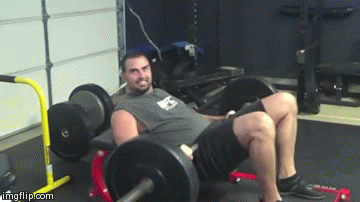
Don't Exist This Creep!
At this signal, many lifters, especially my readers, believe the hip thrust to be the all-time glute development do. Still, the hip thrust also activates the hamstrings, quadriceps, and adductors very thoroughly too. Therefore, it will help develop the unabridged thigh musculature. Throughout the move, the glutes stay nether constant tension, and back forcefulness is not a limiting factor, which cannot be said of other popular glute building movements. This allows for maximal loading of the glute musculature.
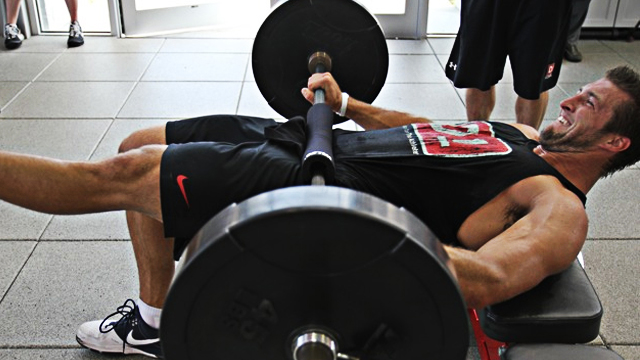
Tim Tebow knows what's up
The hip thrust can be performed for a variety of unlike reasons. Although the popularity of the hip thrust is rising, I still feel its importance is underrated for aesthetics, athletic development, and absolute strength.
The 4 master reasons one should perform hip thrusts include:
- Meliorate the size, force, and appearance of the glutes
- Increase acceleration and sprint speed
- Increase bottom squat and deadlift lockout power
- Amend operation of the unabridged body since the glutes influence foot, talocrural joint, knee, hip, pelvic, and depression back mechanics
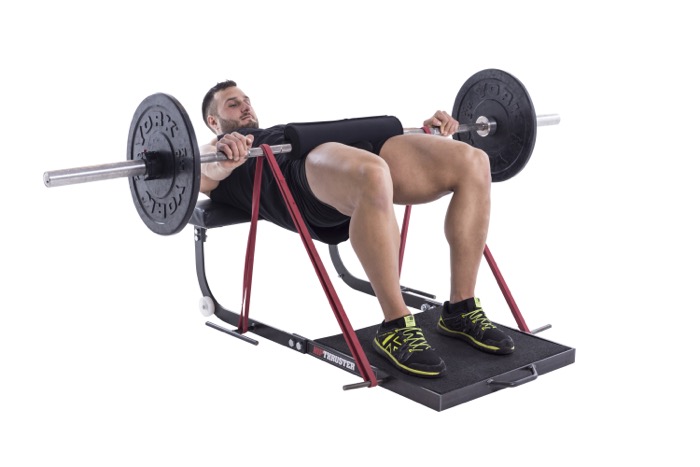
The Hip Thruster is the best manner to do the hip thrust – stable and versatile!
Ways to load the hip thrust
Below are the most common ways to increase the challenge of the hip thrust afterwards mastering bodyweight:
- Barbell
- Band
- Sandbag/Concatenation/Kettlebell/DB (chain variation shown)
- Single Leg Variations
- Shoulder and Feet Elevated Variations

Left: Bodyweight, Eye: Chain Loaded, Right: Single Leg with foot elevated
The Gear up
Demote Superlative
Through experimenting with dissimilar bench heights, I believe the optimal bench height is effectually sixteen inches. This is what most clients feel most comfortable with which is why I designed The Hip Thruster to be this summit. Taller individuals might feel more comfortable with a taller demote and shorter lifters with a shorter demote. In general, a range of 13″-19″ will satisfy 99% of lifters. I recommend that you lot experiment to effigy out a superlative that allows for an like shooting fish in a barrel set-upward and a meridian that allows you feel the most activation in the glutes.
For the regular hip thrust, ready up in a position with the bench lined up at around the bottom of the shoulder blades.
For the American style hip thrust, the pivot bespeak is lower on the back. With the American style, many lifters will observe that they can lift heavier weights. Withal, some lifters won't exist stronger with this variation and must use lighter weights. With the American version, y'all are going to fix upward with the mid back on the bench. With this variation, many find that less pressure is placed on the back, and about feel more loading on the glutes. The movement is performed with a posterior pelvic tilt which natural occurs when placing the back on this position. We've tested three lifters so far in gluteus maximus EMG and take found in all 3 individuals that glute activation is higher with the American version.

Left: American Hip Thrust Set-up, Correct: Regular Hip Thrust Prepare-upward
For both variations, brand certain your back acts every bit a pivot point around the bench. Do not allow your dorsum to slide back and forth during the movement!
Bar Position
To the get the bar in proper position, but coil it right over the feet if using standard size Olympic plates. For those who are but starting out and cannot use 135 lbs, information technology makes information technology difficult to become into the starting position. This is where bumper plates become useful since they are the same diameter as standard Olympic size plates, which allows the lifter to roll the bar right over the thighs to get into position. The smaller plates brand information technology impossible to scroll the bar over the legs onto the hips. If this is the case and you practice not have access to bumper plates, you have two options. Kickoff, you can have a partner lift the bar and gently place it over the hips for you. 2d, yous can deadlift the bar up and sit on the demote, then move down to the ground. Kellie Davis does a great job of demonstrating solutions in THIS blogpost.
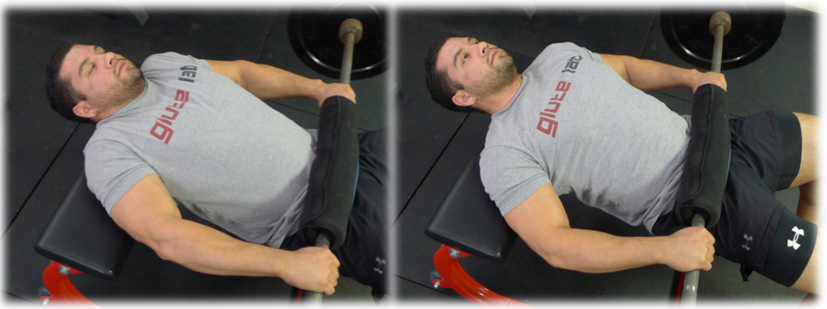
Left: Improper Shoulder Position Shrugging, Right: Shoulders Relaxed
The bar should exist positioned in the crease of the hip with the hands holding the bar into position throughout the movement so the bar does not move forwards or backwards. Be sure to keep the shoulders downward and prevent shrugging when belongings the bar. Some feel more comfy with a supinated grip (some claim this helps improve lat function which subsequently leads to improve glute role), while others prefer a pronated grip. This is entirely upwards to you. Practice not let the bar slide forward or backward during the hip thrust – keep information technology centered over the hips!
Band placement is going to be the same as bar placement on the hips. For those of you who are lucky enough to have access to a Hip Thruster, the band placement is simple. For those of you who aren't so lucky, you lot have to become a little flake more creative. Below are two possible options to set-upward the ring hip thrust without using the Hip Thruster. Options include using the band peg placements in a power rack and looping a band effectually a bar and so stepping on the band (plainly this requires band plus bar tension, and since the bands aren't centered at the hips, it'due south not every bit constructive). I have likewise seen a ready whereby heavy dumbbells anchor the band down, only this option limits the band tension to the sum of the dumbbells used, and then if 120 lb dumbbells are used, then the band tension cannot exceed 240 lbs or else the dumbbells volition rise off the footing.

Protecting Your Hips
Heavy hip thrusting is brutal on the hips. While some lifters can tolerate hip thrusting without whatsoever padding, most volition find the lift excruciatingly painful if padding isn't used. Fifty-fifty worse is that pain will close down muscle activation and prevent the glutes from receiving an optimal grooming stimulus.
There are a few different ways to protect your hips and make the hip thrust comfortable. Below I have listed the nearly popular ways to pad the bar. If y'all currently exercise not have access to any of these, I recommend investing in i of them, as information technology makes the motion much more comfortable. Many lifters are shocked when they finally decide to purchase padding and remark as to how much better their glutes burn down when they hip thrust hurting-free. Other options such as rolling up a do or yoga mat or using a thick towel wrapped around the bar can indeed piece of work, but they are not every bit effective. Y'all tin find these items on Amazon or through a Google search:
- Hampton thick bar pad
- Airex Pad
- Squat Sponge (this is currently our favorite pick – information technology should exist called the hip thrust sponge!)

Left: Airex Pad, Center: Squat Sponge, Correct: Hampton Thick Bar Pad
Anxiety
One time the bar is prepare over the crease of the hips yous volition need to become your anxiety gear up in the proper position. Bring your feet upwardly towards your butt and "screw" the feet into position. This may be difficult depending on the thickness of the pad you lot are using and depending on your body size, but you lot desire to "get tight" by wedging the trunk into proper position. Set your feet so that at the summit of hip thrust, when the hips are fully extended, your shins are vertical. Sometimes the shins won't be vertical and will take a slight bending, but in general you desire to limit this. Toes tin can be pointing directly ahead or turned out slightly. Tinker around to detect the foot position that allows you lot to feel the most glute activation.

Left: Correct Vertical Shins, Right: Incorrect Negative Shin Angle
Execution
While performing the hip thrust, information technology is important to make sure you do not wiggle the weight off the floor but apply a fluid motion instead. I can't stress this enough – you want a smooth hip thrust, not a spastic hip thrust. Once you lot follow the steps above and are in the correct starting position, take a deep breath, brace the core, and bulldoze through the heels, keeping the knees in line with the toes
- Focus on moving the weight with the glutes and not the lower back or hamstrings
- When you approach the top of the movement, stop the lift by contracting your glutes hard and pushing your hips forward. Exercise non overextend the lower back
- Stop the movement with your hips as high as possible while maintaining a neutral spine. At the top of the movement your torso should be parallel to the ground with hips pushed through
- Lower the weight under control keeping tension on the glutes
- Repeat for desired number of reps
Repetitions can be performed by touching the floor on each rep or by reversing in mid-air. There are benefits to both options. By touching the floor on each rep, you tin "reset" each rep and you ensure that you're using full hip ROM. However, by reversing in mid air, you go along constant tension on the glutes which can lead to greater burn and a meliorate glute pump. Some lifters, especially shorter lifters or those with shorter torsos relative to their leg length, will find that the mid-air reversal is much more comfy for their bodies. There's nada wrong with reversing in mid-air. Many women prefer this option, whereas many men prefer to touch the ground on each rep. Tinker around to find what works best for you.
Common Hip Thrust Mistakes
Excessive arching of the low back
This ordinarily occurs because the weight is as well heavy. The glutes aren't strong enough to lock the weight out so the lifter substitutes by arching the back. A more than detailed article on this topic tin be found by clicking HERE.

Left:Poor Overextended Spine, Correct: Skillful Neutral Spine – Notice Apartment Torso
Quick Fix: Reduce the load and brace the core throughout the whole range of motility. Focus on only moving at the hips and on not assuasive movement to occur at the lumbar spine.
Improper neck positioning
Going into cervical flexion can exist problematic for some lifters, causing cramping and neck discomfort.
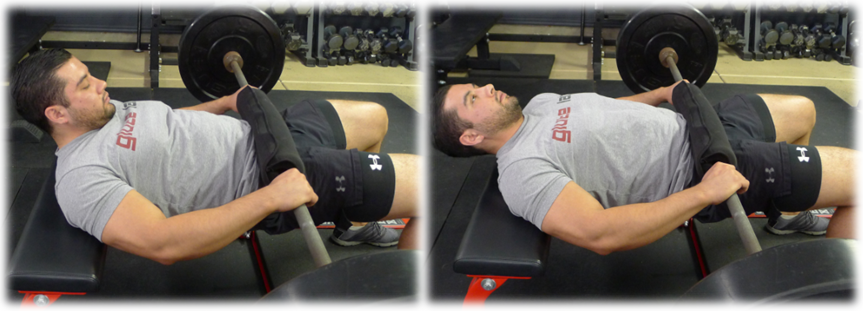
Left:Poor Flexed Neck, Right: Skillful Neutral Neck
Quick Set up: Be sure to maintain a neutral neck position throughout the motion
Insufficient hip extension
Failing to reach total hip extension is also normally due to the load being too heavy. This tin can besides happen on account of extremely tight hip flexors.
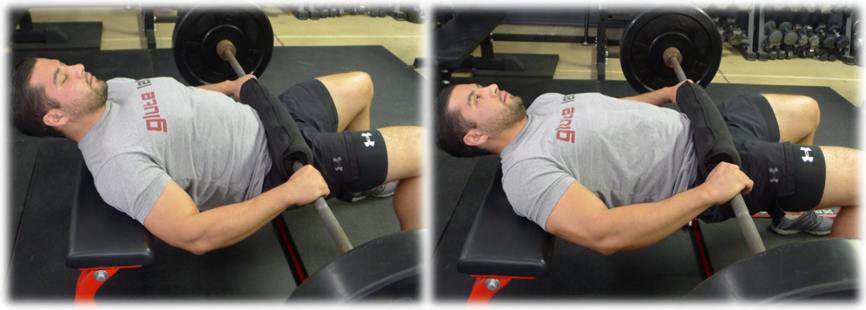
Left: Poor – Failure to achieve total hip extension, Right: Expert total hip extension
Quick Fix: Driblet the weight, allowing y'all to completely lock out and terminate the movement. Also some static or dynamic stretching of the hip flexors (particularly the rectus femoris) before or in between sets can assist.
Ascent up onto toes
This typically occurs with people who don't know how to perform the movement properly and with those who are very quad dominant

Left:Poor – Rising onto toes, Right: Good – Feet flat driving through heels
Quick Prepare: Keep your toes on the flooring and focus on pushing through the heels throughout the set (you tin can also dorsiflex and lift the toes if this helps)
For a more in longer in depth await at the hip thrust bank check out this video:
To encounter the evolution of the hip thrust, including all the different practice variations possible, click on THIS link. To read up on the science behind the hip thrust, click Here.
At this betoken, you should accept a sound agreement of how to perform the hip thrust and of what is considered proper course and technique. There should be no more excuses for a lack of glute development. Pick your glute edifice poison and get to work.
Source: https://bretcontreras.com/how-to-hip-thrust/

0 Response to "How To Set Up Barbell Hip Thrust"
Post a Comment